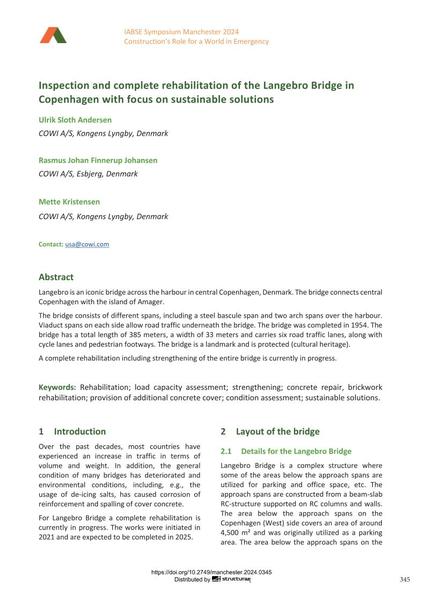Inspection and complete rehabilitation of the Langebro Bridge in Copenhagen with focus on sustainable solutions

|
|
|||||||||||
Détails bibliographiques
| Auteur(s): |
Ulrik Sloth Andersen
(COWI A/S, Kongens Lyngby, Denmark)
Rasmus Johan Finnerup Johansen (COWI A/S, Esbjerg, Denmark) Mette Kristensen (COWI A/S, Kongens Lyngby, Denmark) |
||||
|---|---|---|---|---|---|
| Médium: | papier de conférence | ||||
| Langue(s): | anglais | ||||
| Conférence: | IABSE Symposium: Construction’s Role for a World in Emergency, Manchester, United Kingdom, 10-14 April 2024 | ||||
| Publié dans: | IABSE Symposium Manchester 2024 | ||||
|
|||||
| Page(s): | 345-353 | ||||
| Nombre total de pages (du PDF): | 9 | ||||
| DOI: | 10.2749/manchester.2024.0345 | ||||
| Abstrait: |
Langebro is an iconic bridge across the harbour in central Copenhagen, Denmark. The bridge connects central Copenhagen with the island of Amager. The bridge consists of different spans, including a steel bascule span and two arch spans over the harbour. Viaduct spans on each side allow road traffic underneath the bridge. The bridge was completed in 1954. The bridge has a total length of 385 meters, a width of 33 meters and carries six road traffic lanes, along with cycle lanes and pedestrian footways. The bridge is a landmark and is protected (cultural heritage). A complete rehabilitation including strengthening of the entire bridge is currently in progress. |
||||
| Mots-clé: |
renforcement solutions durables
|
||||
